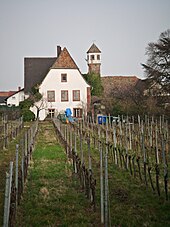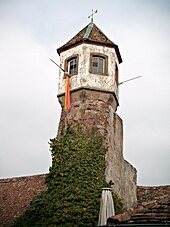Heilsbruck monastery
| Cistercian convent Heilsbruck | |
|---|---|
 Heilsbruck monastery from the south |
|
| location | Germany Rhineland-Palatinate |
| Lies in the diocese | Speyer |
| Coordinates: | 49 ° 17 '0.1 " N , 8 ° 6' 53.7" E |
| founding year | 1232 in Harthausen , from 1262 in Edenkoben |
| Year of dissolution / annulment |
1560 |
| Mother monastery | Koenigsbruck Monastery |
Heilsbruck Monastery was a Cistercian abbey that was located in what is now the Rhineland-Palatinate community of Edenkoben and some remains of it have been preserved; today it is a winery.
history
A native of the local region Würzburg canon Salomon wanted to found a Cistercian convent in his homeland. In 1230, he won a supporter in the wealthy Speyer citizen and former mayor Elbewin Schwarz, who donated property to the monastery project in Harthausen . Two years later, the planned monastery was founded there; it was occupied by nuns from the Koenigsbruck monastery in Alsace . The Speyer bishop Beringer von Entringen confirmed the foundation in 1232.
Because of the swampy soil and the lack of clean drinking water and firewood, the sisters found it worthwhile to move to another location after around 30 years. They asked the Cistercian Abbot of Eusserthal , to whom they were spiritually subordinate, to intercede with the Speyer Bishop Heinrich von Leiningen for the intended move; he gave his permission in 1262. The monastery then acquired the sovereignty, bailiwick and church patronage rights over the neighboring villages of Edenkoben and Wazzenhofen from Knight Burkard von Breitenstein . In the latter they settled their new monastery on the edge of the Haardt . It developed quickly and successfully, not least because it owned high-quality vineyards. In 1281 King Rudolf von Habsburg placed it under the protection of the empire, while Emperor Ludwig the Bavarian renewed the monastery’s rights and freedoms in 1339. In 1408 King Ruprecht issued him a letter of protection and appointed his son, Elector Ludwig III. from the Palatinate , as well as its successor, to patronage of the convention. By 1500 he was wealthy in 46 towns.
During the Palatinate Peasants' War , Heilsbruck Abbey was plundered and devastated in the spring of 1525 (after Easter). Under Abbess Sophia Kistel von Dürkheim, the facility was renovated and a new Gothic church, monastery building and a deep wine cellar were built on the ruins. Remnants have been preserved from them. The monastery did not recover from the debt caused by the reconstruction.
The Palatinate Elector Friedrich III. had the convent dissolved in 1560 in the wake of the Reformation. Goods and income were added to the electoral administration in 1565 and administered by a monastery attendant.
When the area came under Catholic influence again at times during the Thirty Years War , Jesuits from Speyer settled in Heilsbruck from 1636 . In 1646 the Cistercian nuns moved there again and wanted to revive the nunnery. As early as 1648, due to the Peace of Westphalia, the pre-war status had to be restored. The nuns finally left Heilsbruck and monastic life died out. Apparently the secular monastery was leased to Mennonites from Switzerland, as Swiss family names prevailed among the residents of the 17th and 18th centuries. This also happened in other dissolved monasteries in the region.
After the Electors of the Palatinate became Catholics again in the 18th century, Catholics seem to have used the Heilsbruck church again at times. The regional historian Johann Goswin Widder wrote in 1787 that mass was only celebrated there on Corpus Christi day.
As part of the German territories on the left bank of the Rhine , Heilsbruck, whose associated village Wazzenhofen was now part of Edenkoben, fell to France. The revolutionary government auctioned the monastery property on May 21, 1805 in Mainz . Landau citizens Louis Keller and Georg Albert Mayer became the owners . At that time the property was described as: “Leasehold building, courtyard, barn, cellar house, an old church, part of the cloister , the monastery building, vineyards, meadows, garden and accessories of the so-called Heiligbrucher monastery.” The owners of the current winery subsequently changed several times, the ancestors of the current owners have lived there since 1898. In the auction record of 1805 the church is mentioned, which in the meantime - apart from a small remainder - no longer exists; In 1824 the Mannheim author Johann Georg Rieger (1798–1838) described it as still in existence. Franz Xaver Remling stated in 1832 that the monastery property had passed to new owners the year before. The recently deceased previous owner Georg Albert Mayer had the church demolished, with the exception of a turret that served him as a “Belvedere” (viewpoint). Remling also mentions that the Edenkoben Corpus Christi procession moved to the Heilsbruck monastery church until the beginning of the 19th century.
Today's building stock
The winery has the Edenkoben address "Klosterstrasse 170". It is largely surrounded by a wall, which is the mightiest in the northeast, towards Klosterstrasse, and also has five thick buttresses on the street side . Here it has the character of a fortification. Within the area are vineyards and gardens, with today's courtyard on the east side. It is a long manor house with a crooked hip roof. In essence, it is the refectory , rebuilt at the beginning of the 16th century , but redesigned in a classical style. On the north side there is a small arched door with the Latin year 1552. To the east and south are agricultural buildings, the east rests on a groin-vaulted cellar with a cruciform floor plan that used to support the church. From this a Gothic stair tower has been preserved, on which the landowner Georg Albert Mayer had a hexagonal structure built in the early 19th century. In the courtyard between the manor house and the outbuildings there is a large, Gothic fountain bowl, which probably comes from the former cloister. In addition to an old boundary stone with the monogram of the Heilsbruck monastery, there are also two very simple, medieval tombstones (13th century); one from the grave of a child named Elisabeth , the other from that of the nobleman Conrad von Altdorff, a benefactor of the convent. In a newly built wall west of the courtyard is a medieval stone stone with an inscription.
In Speyer, Heydenreichstrasse 8, was the Heilsbrucker Klosterhof , parts of which from the 16th century have been preserved (e.g. the octagonal stair tower).
There was also a Heilsbrucker Gut in Harthausen until the 18th century. A lily in the local coat of arms reminds of the monastery founded here; the event and sports hall of the village is called Heilsbruckhalle .
Monastery coat of arms
The coat of arms of the monastery has u. a. Preserved on an old boundary stone that is now placed in the courtyard of the property. It is a bridge-like “H” for Heilsbruck, with an upright abbess staff.
The regional historian Johann Franz Capellini von Wickenburg , in the Thesaurus Palatinus (Volume 1), has a drawing of a memorial stone of Abbess Sophia Kistel von Dürkheim from 1534, which shows the same coat of arms, from the time the monastery was built in the 16th century .
gallery
literature
- Franz Xaver Remling : Documented history of the Heilsbruck monastery above Edenkoben , Mannheim, 1832, (digital scan)
- Michael Frey : Attempt of a geographical-historical-statistical description of the Royal Bavarian Rhine District , Volume 2, Speyer, 1836, p. 164 u. 165; (Digital scan)
- Michael Frey: Attempt of a geographical-historical-statistical description of the Royal Bavarian Rhine District, Volume 1, Speyer, 1836, pp. 221-233; (Digital scan)
- Lorenz Braun: 700 years of Heilsbruck Monastery , anniversary publication, 1962
- Dieter Bührig: Southern Wine Route and Palatinate Forest: 66 favorite places and 11 winegrowers , p. 29, Gmeiner-Verlag, 2012, ISBN 3-8392-3885-4 ; (Digital scan)
Web links
- Historical site of the Heilsbruck monastery
- General Directorate for Cultural Heritage Rhineland-Palatinate (ed.): Informational directory of cultural monuments - Southern Wine Route district. Mainz 2020, p. 27 (PDF; 10 MB).
- Website of the Heilsbruck Monastery, with a list of the abbesses
- Website of the Heilsbruck Monastery, with a brief history
- Document of the monastery from 1365 and further monastery documents from the same year in the German Digital Library
Individual evidence
- ↑ Johannes von Geissel: Der Kaiser-Dom zu Speyer: a topographical-historical monograph , 2nd volume, p. 200, Mainz, 1828 (digital scan)
- ^ Johann Goswin Widder : Attempt of a complete geographical-historical description of the electoral prince. Pfalz am Rheine , Volume 2, p. 287, Frankfurt am Main, 1786; (Digital scan)
- ^ Johann Georg Rieger (1798-1838): Historical-topographical-statistical description of Mannheim and its surroundings , Mannheim, 1824, p. 542; (Digital scan)
- ^ Franz Xaver Remling : Documentary history of the Heilsbruck monastery above Edenkoben , Mannheim, 1832, p. 69; (Digital scan)
- ↑ Peter Gärtner: History of the Bavarian-Rhineland Palatinate castles and the families who formerly owned them, Volume 2, p. 407, Speyer, 1854; (Scan to the local noble family of Altdorf)
- ^ Franz Xaver Remling : Documentary history of the Heilsbruck Abbey above Edenkoben , Mannheim, 1832, p. 28; (Digital scan)
- ^ Rheinisches Landesmuseum in Bonn: Bonner Jahrbücher , volumes 91–93, 1892, p. 221, (detail scan 1) , (detail scan 2)
- ↑ Website on the Harthausen coat of arms















